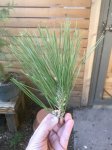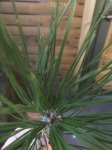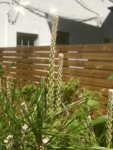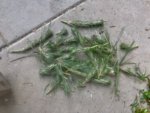You are using an out of date browser. It may not display this or other websites correctly.
You should upgrade or use an alternative browser.
You should upgrade or use an alternative browser.
JPB development
- Thread starter parhamr
- Start date
parhamr
Omono
Yeah! That's close to where I might be headed with this.Hi,
I don't know if the branch placement is right for this, but I am seeing an interesting tree in this angle with another twist forward...
Just a thought.
Paradox
Marine Bonsologist
It's been a month since you repotted. Now you can start adding fertilizer cakes or teabags. Start with two this week, then next week add two more, then the next week add two more...
Do you ramp up the amount like this with all trees on the spring or just ones that have been repotted during the current year?
All the trees I want to get spring fertilizer to get "ramped up". Freshly repotted trees get about a one month delay after repotting before I begin fertilizing.Do you ramp up the amount like this with all trees on the spring or just ones that have been repotted during the current year?
parhamr
Omono

The tree shows pretty good vigor. This year's needles are reflecting my watering and feeding routines at 4" and longer. The organic 5-5-5 granulated fertilizer I use has been consistently breaking down, which suggests healthy mycorrhizae.
This season is doing what I've wanted: restoring health and setting new, inner buds.
Growing tips look pretty good. All have at least 2 buds set that look robust. A few tips have many buds.
just.wing.it
Deadwood Head
Wow, looking bushy now! Nice!
dirk hoorelbeke
Omono
happy
parhamr
Omono
Attachments
parhamr
Omono
sorce
Nonsense Rascal
parhamr
Omono
LanceMac10
Imperial Masterpiece
Will you decandle this spring/summer?
I'd be tempted to snap it in half....or more.
Looks like a happy Pinus!?!?










I'd be tempted to snap it in half....or more.
Looks like a happy Pinus!?!?
LanceMac10
Imperial Masterpiece
How did I miss this thread....(murmurs to self).....



parhamr
Omono
That particular candle will be an escape branch to thicken the trunk. Many other candles will be left alone to generate traffic to stimulate backbudding and to keep water moving through weaker sections. (This year’s backbudding was great and a taste of what is to come when the tree is stronger overall!)Will you decandle this spring/summer?
I'd be tempted to snap it in half....or more.
I might only snap about 1/8 of the candles in the strongest parts of the tree this summer.
Next year I will begin the more aggressive techniques
parhamr
Omono
Ohhhkay I decandled about 75 percent of the tree, and mostly in the top and middle. I’m guessing the second flush will end up only slightly longer than desired by the time it fully hardens.
In total I removed 46 candles and also slightly shortened 4 branches.
Fingers crossed for success!
In total I removed 46 candles and also slightly shortened 4 branches.
Fingers crossed for success!
Attachments
Brian Van Fleet
Pretty Fly for a Bonsai Guy
What made you decide to decandle your JBP now? If you’re trying to improve primary/secondary branch structure, decandling isn’t as effective as good pruning in early spring back to proximal shoots, letting it grow all summer, and pruning it again in the fall, selecting evenly-sized buds and branches, and keeping growth in close to the trunk.
I have found that a second flush of JBP growth takes about 100 days to mature, so find your first frost date (10/18 in Portland) and count backwards 100 days, or 14 weeks. This puts your summer candle-cutting at around 7/12, and you could probably hedge toward earlier if your late summers are really rainy/cloudy. Doing it too early means that the tree hasn’t had the benefit of synthesizing on new, more efficient growth for these few weeks, and that the second flush of candles has too much growing season left to produce long needles.
I’m sure it will be fine, but something to keep in mind if you end up with too-long needles at the end of the year.
I have found that a second flush of JBP growth takes about 100 days to mature, so find your first frost date (10/18 in Portland) and count backwards 100 days, or 14 weeks. This puts your summer candle-cutting at around 7/12, and you could probably hedge toward earlier if your late summers are really rainy/cloudy. Doing it too early means that the tree hasn’t had the benefit of synthesizing on new, more efficient growth for these few weeks, and that the second flush of candles has too much growing season left to produce long needles.
I’m sure it will be fine, but something to keep in mind if you end up with too-long needles at the end of the year.
Bingo!What made you decide to decandle your JBP now? If you’re trying to improve primary/secondary branch structure, decandling isn’t as effective as good pruning in early spring back to proximal shoots, letting it grow all summer, and pruning it again in the fall, selecting evenly-sized buds and branches, and keeping growth in close to the trunk.
I have found that a second flush of JBP growth takes about 100 days to mature, so find your first frost date (10/18 in Portland) and count backwards 100 days, or 14 weeks. This puts your summer candle-cutting at around 7/12, and you could probably hedge toward earlier if your late summers are really rainy/cloudy. Doing it too early means that the tree hasn’t had the benefit of synthesizing on new, more efficient growth for these few weeks, and that the second flush of candles has too much growing season left to produce long needles.
I’m sure it will be fine, but something to keep in mind if you end up with too-long needles at the end of the year.
Also, are you doing the “one day decandling”? Or the “10 day” method?
At any rate, with each of the methods, you decandle the bottom, or weakest part of tree, too. Let’s assume you are doing the 10 day method. Do the weakest part, the lower parts first! Then 10 days later, do the middle section, then 10 days after that, do the strongest part. Why? Doing the weaker part first gives it a longer growing season to recover. Doing the strongest part last keeps it in check. So the weak part gets to grow for a longer period of time. The end result? When the summer growth gardens off in the fall, it’s all about the same strength! This is called “balancing the tree”.
The one day decandling method leaves longer stubs on the strong candles, and virtually none on the weak ones. The stubs still contain some auxin, and the auxin suppresses the new shoot for a while until the stubs dry up.
Potawatomi13
Imperial Masterpiece
markyscott
Imperial Masterpiece
Ohhhkay I decandled about 75 percent of the tree, and mostly in the top and middle. I’m guessing the second flush will end up only slightly longer than desired by the time it fully hardens.
In total I removed 46 candles and also slightly shortened 4 branches.
Fingers crossed for success!
Looks like nice strong healthy growth. I’m pleased to see it and I’m sure it will send out a good set of summer shoots for you. I like to keep a record of when I decandle so that I can adjust as necessary to tweak the needle length. Late May/early June seems like the about right time of year in the PNW - that’s when I recall doing it when I lived there. Here in Houston I do it after July 4th and before mid August. Any later and I run the risk of the tree just setting buds with no summer shoots. This is the fall decandling technique that Brian is talking about. It’s different and can be very effective for pushing back budding. It might be something you consider at some point in the future.
S
just.wing.it
Deadwood Head
This method is for trees in what stage of growth?Bingo!
Also, are you doing the “one day decandling”? Or the “10 day” method?
At any rate, with each of the methods, you decandle the bottom, or weakest part of tree, too. Let’s assume you are doing the 10 day method. Do the weakest part, the lower parts first! Then 10 days later, do the middle section, then 10 days after that, do the strongest part. Why? Doing the weaker part first gives it a longer growing season to recover. Doing the strongest part last keeps it in check. So the weak part gets to grow for a longer period of time. The end result? When the summer growth gardens off in the fall, it’s all about the same strength! This is called “balancing the tree”.
The one day decandling method leaves longer stubs on the strong candles, and virtually none on the weak ones. The stubs still contain some auxin, and the auxin suppresses the new shoot for a while until the stubs dry up.
If you want to thicken the trunk, or thicken a primary branch, would you still decandle?






